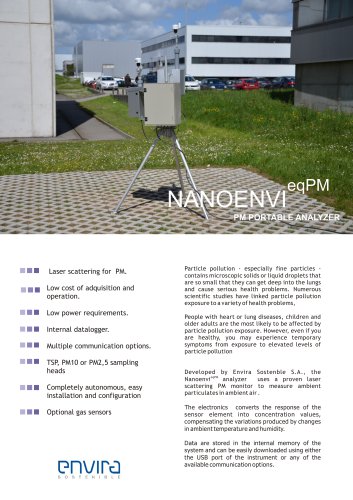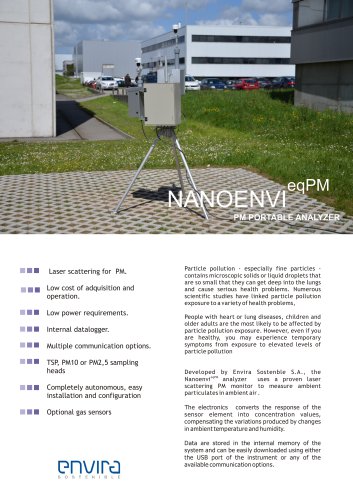
Catalog excerpts

1. Scientific evidence: WHO According to the World Health Organization (WHO), people spend between 75 and 90% of their time indoors, where the air quality is, according to the EPA (US Environmental Protection Agency) 2 to 5 times worse than outdoors. For this reason, improving indoor air quality is becoming increasingly important in a society concerned about the health of its citizens. In recent years, numerous scientific investigations have been carried out that show the effects of acute or chronic toxicity in relation to exposure to pollutants in indoor environments. In 1982, the WHO...
Open the catalog to page 2
1. Scientific evidence: What does the data say? 90% spend time indoors of illnesses are caused by agravated poor IAQ 2 to 5 Worst pollution indoors tan outdoors
Open the catalog to page 3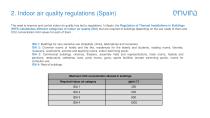
2. Indoor air quality regulations (Spain) The need to improve and control indoor air quality has led to regulations. In Spain, the Regulation of Thermal Installations in Buildings (RITE) establishes different categories of indoor air quality (IDA) that are required of buildings depending on the use made of them and CO2 concentration limit values for each of them . IDA 1: Buildings for very sensitive use (hospitals, clinics, laboratories and nurseries). IDA 2: Common rooms of hotels and the like, residences for the elderly and students, reading rooms, libraries, museums, courtrooms, schools...
Open the catalog to page 4
3. Indoor air quality standards (international) ASHRAE (American Society of Heating, Refrigeration and Air Conditioning Engineers) has developed standards that are an international reference for maintaining adequate air quality in buildings. The most outstanding: • ASHRAE Standard 62.1-2019 for Commercial and Institutional Buildings. ASHRAE Standard 62.2-2019 for Residential Buildings. What is the recommended maximum concentration of carbon dioxide (CO2)? ASHRAE recommends that the maximum indoor CO2 level be 700 ppm. Once this concentration is exceeded, it is necessary to carry out...
Open the catalog to page 5
4. Certificacions: Air quality also affects the way buildings are constructed, such as the materials used or the type of facilities. That is why certifications such as RESET, LEED or WELL have emerged: Certification focused on the continuous monitoring of air quality inside buildings through the use of specific sensors to measure certain parameters Smart building evaluation method where fundamental aspects are assessed to certify the sustainability of buildings. One of them is indoor air quality. Scientifically backed qualification system to certify and monitor the characteristics of a...
Open the catalog to page 6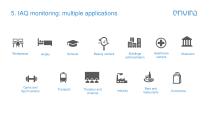
5. IAQ monitoring: multiple applications Gyms and Sport centers Beauty centers Buildings administration Healthcare centers
Open the catalog to page 7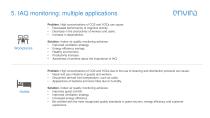
5. IAQ monitoring: multiple applications Problem. High concentrations of CO2 and VOCs can cause: • Decreased performance of cognitive activity. • Decrease in the productivity of workers and users. • Increase in absenteeism. Solution. Indoor air quality monitoring achieves: • Improved ventilation strategy. • Energy efficiency savings. • Healthy environment. • Productivity increase. • Awareness of workers about the importance of IAQ. Problem. High concentrations of CO2 and VOCs due to the use of cleaning and disinfection products can cause: • Nasal and eye irritations in guests and workers. •...
Open the catalog to page 8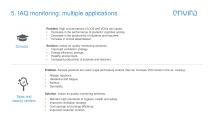
5. IAQ monitoring: multiple applications Problem. High concentrations of CO2 and VOCs can cause: • Decrease in the performance of students' cognitive activity. • Decrease in the productivity of students and teachers. • Increase in school absenteeism. Solution. Indoor air quality monitoring achieves: • Improved ventilation strategy. • Energy efficiency savings. • Healthy environment. • Increased productivity of students and teachers. Problem. Aerosol products are used in spa and beauty centers that can increase VOC levels in the air, causing: • • • • Spas and beauty centers Allergic...
Open the catalog to page 9
5. IAQ monitoring: multiple applications Problem. High concentrations of CO2 and VOCs inside administration buildings can cause: • Decreased performance of cognitive activity. • Decrease in the productivity of workers and users. • Increase in absenteeism. Administration buildings Solution. Indoor air quality monitoring achieves: • Improved ventilation strategy. • Energy efficiency savings. • Healthy environment. • Productivity increase. • Awareness of workers about the importance of CAI. Problem. Factors such as the occupants, their activity, the design of the building, its materials and...
Open the catalog to page 10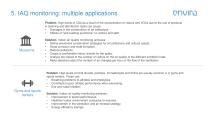
5. IAQ monitoring: multiple applications Problem. High levels of CO2 as a result of the concentration of visitors and VOCs due to the use of products in cleaning and disinfection tasks can cause: • Damages in the conservation of art collections. • Effects of "sick building syndrome" on visitors and staff. Solution. Indoor air quality monitoring achieves: • Define preventive conservation strategies for art collections and cultural assets. • Avoid corrosion and mold formation. • Reduce pollutants. • Create a comfortable indoor climate for the public. • Analyze the impact of the number of...
Open the catalog to page 11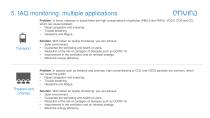
5. IAQ monitoring: multiple applications Problem: In trains, subways or buses there are high concentrations of particles (PM2.5 and PM10), VOCS, CO2 and CO, which can cause between: • Nasal congestion and sneezing. • Trouble breathing • Headache and fatigue. Solution. With indoor air quality monitoring, you can achieve: • Safer environment. • Guarantee the well-being and health of users. • Reduction of the risk of contagion of diseases such as COVID-19. • Improvement in the ventilation and air renewal strategy. • Maximize energy efficiency. Problem: In spaces such as theaters and cinemas,...
Open the catalog to page 12
5. IAQ monitoring: multiple applications Problem: Although industrial facilities have emissions monitoring solutions, it is possible that the high concentration of CO2, CO or PM particles could end up affecting indoor spaces such as offices causing: • Decrease in productivity and work performance • Increase in absenteeism • Effects of 'sick building syndrome' such as headache, fatigue, eye and nasal irritation. Solution. With indoor air quality monitoring, the following is achieved: • Maintain high standards of hygiene, health and safety. • Improved ventilation strategy. • Cost savings and...
Open the catalog to page 13All Envira catalogs and technical brochures
-
NANOENVI eqPM
2 Pages
-
UrVAMM
2 Pages
-
Nanoenvi IAQ®
16 Pages
-
DS DataLogger
2 Pages


